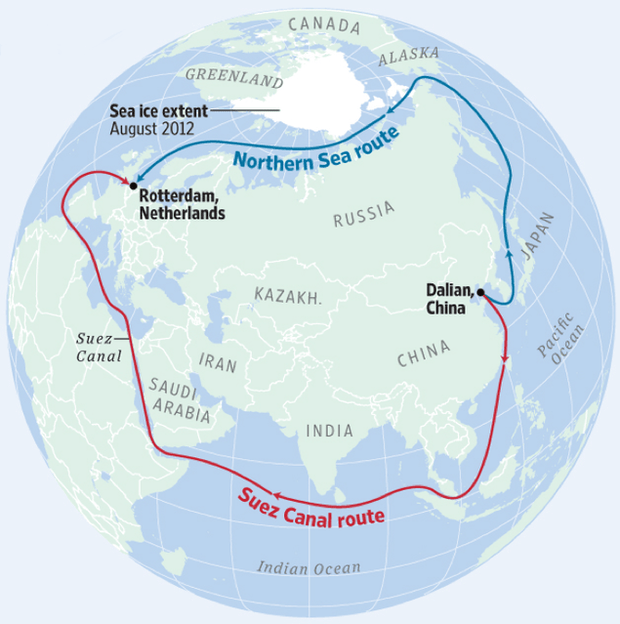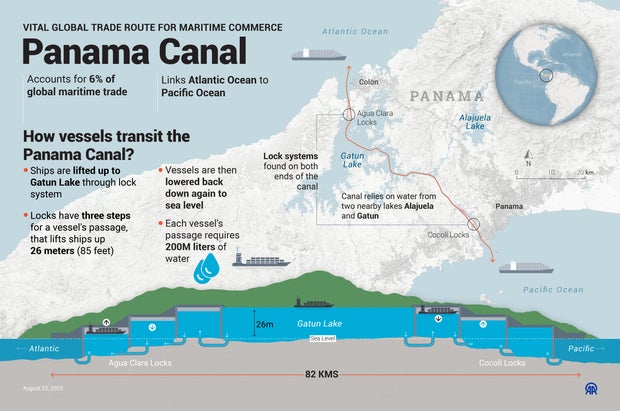During a long press conference on Tuesday, President-elect Donald Trump spoke of his interest in securing the United States Control of Greenland and the Panama CanalHe said he did not rule out the use of military force.
Here’s a look at the two places and why Trump might want the United States to control them.
Where is Greenland located and why does Trump want to control it?
Greenland is located to the northeast of Canada and is largely covered by the Greenland Ice Sheet. It is the largest island in the world, but it is inhabited by only about 60,000 people. It is a semi-autonomous region of the Kingdom of Denmark, and has its own elected government.
Its location between the United States, Russia, and Europe makes it highly strategic for economic and defense purposes – especially as sea ice melts Opening new shipping routes through the Arctic.
It is also the location of the northernmost American military base.
“We need Greenland for national security purposes,” Trump said Tuesday. “I’m talking about protecting the free world. Look out – you don’t even need binoculars – look out. You’ve got Chinese ships everywhere. You’ve got Russian ships everywhere. We’re not going to allow that.” We don’t allow that to happen.”
European University in Saint Petersburg
Greenland also has oil, natural gas and rare mineral resources, some of which are used in products including military technology and electric vehicles, and which currently originate mostly from Russia and China.
What is the Panama Canal and why does Trump want it?
About 40% of U.S. container shipments currently pass through the Panama Canal, according to trade publication CargoNOW. The canal serves as a shortcut between the Pacific Ocean, the Caribbean Sea, and later the Atlantic Ocean.
Trump said the United States needs the Panama Canal for “economic security,” falsely claiming that the canal is “run by China.”
“The Panama Canal is vital to our country. It’s run by China. China! And we gave the Panama Canal to Panama. We didn’t give it to China, and they abused it. They abused that gift. It never should have been done,” Trump said.
Panamanian President Jose Raul Molino has questioned this.
“There is absolutely no Chinese interference or involvement in anything related to the Panama Canal,” he said in late December.
Elmurad Usupaliev/Anadolu Agency/Getty
Panamanian Foreign Minister Javier Martinez Acha said Tuesday that his government had not formally spoken with Trump or his team about the canal recently, but he repeated previous comments by the country’s president that the canal would remain under Panamanian control.
Martinez Acha said: “Sovereignty over our canal is non-negotiable and is part of our irreversible history of struggle and conquest.”
History of Greenland
The Kingdom of Denmark began colonizing Greenland in the early 18th century, hundreds of years after Vikings from the same distant land first arrived to establish their abode. It was not until World War II that the United States established a presence on the island, when the then Danish ambassador to the United States, Henrik Kaufmann, refused to surrender to the rule of the Nazi occupiers in Denmark.
Denmark was liberated from Nazi occupation in 1945, but the United States never left its military base, the Petovik Space Base, which remains to this day the northernmost American military facility.
History of the Panama Canal
the Panama Canal It was built by the United States between 1904 and 1914. It serves as a shortcut between the Pacific Ocean and the Caribbean, greatly shortening shipping routes from Asia to ports in the eastern United States.
It was operated by the United States government for the first time in decades, causing tension with Panama.
In the 1970s, the United States and Panama signed a treaty agreeing to the permanent neutrality of the canal. The United States committed to relinquishing control of the canal, and did so entirely in 1999. The canal is now managed by the Panama Canal Authority.
https://assets2.cbsnewsstatic.com/hub/i/r/2021/02/23/dcdd9752-e311-446c-9c63-9bccced2d231/thumbnail/1200x630g2/af6dbd2713782192b96db590a1734318/northern-sea-route-suez-canal-route.png?v=6ffea931a1e284729a23a55e2e39c4e9
Source link

